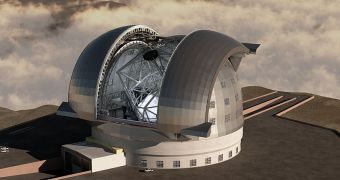Officials with the governing body of the European Southern Observatory (ESO) recently approved the organization's 2012 spending plan, which certified that construction on the largest telescope in the world will begin next year.
With the necessary funds secured, engineers will begin laying the foundation for the European Extremely Large Telescope (E-ELT). The immense facility will be constructed atop Cerro Armazones, a mountain located in the center of the Atacama Desert, Chile.
In addition to holding the record for the largest-aperture telescope ever, the installation will also boast several new technologies. It will collect light using an innovative setup consisting for five mirrors, of which the primary one will have a diameter of 42 meters (137.79 feet).
The observatory will collect light in optical and near-infrared wavelengths, and will be able to gather 15 times more photons than any other ground-based telescope in existence today. The total surface area of its main mirror will cover 1,300 square meters (13,993 square feet).
The reflector-type observatory will also feature a 5.9-meter (19.35-foot) secondary mirror. The entire facility will be placed on a nasmyth mount, and will have a focal length of f/10 to f/20, or between 420 and 840 meters (1,377 to 2,755 feet).
Due to its amazing specs, the machine will be entirely capable of imaging Earth-sized extrasolar planets in orbit around their Sun-like stars. This is one of the main reasons why the observatory is being built in the first place.
According to ESO, the construction process should take between 10 and 11 years, so first light is currently tentatively scheduled for 2022. “The E-ELT is starting to become reality,” a statement from the ESO Director General, Tim de Zeeuw, reads.
“However, with a project of this size it is expected that approval of the extra expenditure will take time. Council at the same time recognizes that preparatory work must start now in order for the project to be ready for a full start of construction in 2012,” the document adds, as quoted by Space.
When the E-ELT is complete, ESO will become the most powerful collection of observatories in the world. Already, the organization operates the Paranal Observatory, where the Very Large Telescope is located, and the Las Silla Observatory, home to the New Technology Telescope. They are all located in Chile.

 14 DAY TRIAL //
14 DAY TRIAL //